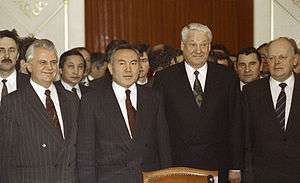Alma-Ata Protocol
 Signing ceremony | |
| Type | Treaty establishing a founding declarations and principles of the Commonwealth of Independent States (CIS). |
|---|---|
| Signed | 21 December 1991 |
| Location | Alma-Ata, Kazakhstan |
| Effective | 21 December 1991 |
| Signatories |
|
The Alma-Ata Protocols are the founding declarations and principles of the Commonwealth of Independent States (CIS).
The leaders of Russia, Ukraine, and Belarus had agreed to the Belavezha Accords on 8 December 1991, dissolving the Soviet Union and forming the CIS. On 21 December 1991, Armenia, Azerbaijan, Belarus, Kazakhstan, Kyrgyzstan, Moldova, Russia, Tajikistan, Turkmenistan, Ukraine, and Uzbekistan agreed to the Alma-Ata Protocols, joining the CIS. The latter agreement included the original three Belavezha signatories, as well as eight additional former Soviet republics. Lithuania, Latvia, Estonia, and Georgia were the only former republics that have not participated. [1]
More surprisingly, the protocol allowed the Russian Federation (RSFSR) to assume the Soviet Union's UN membership, including its permanent seat on the United Nations Security Council.
References
- ↑ "THE ALMA-ATA DECLARATION". Federal Research Division / Country Studies / Area Handbook Series / Belarus / Appendix C. Library of Congress.
External links
- The Alma-Ata Protocols (Russian language). Archive of Egor Gaidar
- The Alma-Ata Protocols (Russian language)
- English translation
